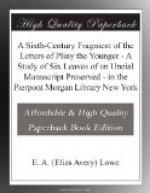In dating uncial manuscripts we must proceed warily, since the data on which our judgments are based are meagre in the extreme and rather difficult to formulate.
The history of uncial writing still remains to be written. The chief value of excellent works like Chatelain’s Uncialis Scriptura or Zangemeister and Wattenbach’s Exempla Codicum Latinorum Litteris Maiusculis Scriptorum lies in the mass of material they offer to the student. This could not well be otherwise, since clear-cut, objective criteria for dating uncial manuscripts have not yet been formulated; and that is due to the fact that of our four hundred or more uncial manuscripts, ranging from the fourth to the eighth century, very few, indeed, can be dated with precision, and of these virtually none is in the oldest class. Yet a few guide-posts there are. By means of those it ought to be possible not only to throw light on the development of this script, but also to determine the features peculiar to the different periods of its history. This task, of course, can not be attempted here; it may, however, not be out of place to call attention to certain salient facts.
The student of manuscripts knows that a law of evolution is observable in writing as in other aspects of human endeavor. The process of evolution is from the less to the more complex, from the less to the more differentiated, from the simple to the more ornate form. Guided by these general considerations, he would find that his uncial manuscripts naturally fall into two groups. One group is manifestly the older: in orthography, punctuation, and abbreviation it bears close resemblance to inscriptions of the classical or Roman period. The other group is as manifestly composed of the more recent manuscripts: this may be inferred from the corrupt or barbarous spelling, from the use of abbreviations unfamiliar in the classical period but very common in the Middle Ages, or from the presence of punctuation, which the oldest manuscripts invariably lack. The manuscripts of the first group show letters that are simple and unadorned and words unseparated from each other. Those of the second group show a type of ornate writing, the letters having serifs or hair-lines and flourishes, and the words being well separated. There can be no reasonable doubt that this rough classification is correct as far as it goes; but it must remain rough and permit large play for subjective judgement.
A scientific classification, however, can rest only on objective criteria—criteria which, once recognized, are acceptable to all. Such criteria are made possible by the presence of dated manuscripts. Now, if by a dated manuscript we mean a manuscript of which we know, through a subscription or some other entry, that it was written in a certain year, there is not a single dated manuscript in uncial writing which is older than the seventh century—the oldest manuscript with a precise date known




